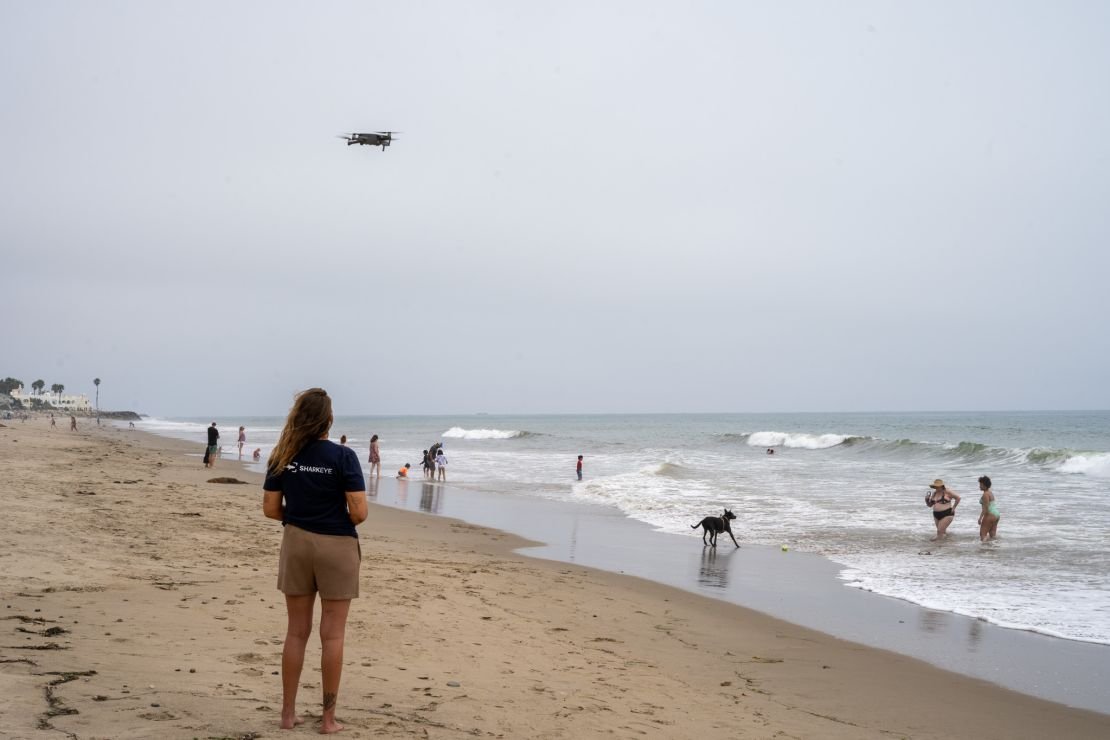CNN
–
On summer mornings, local kids like to gather at Padaro Beach in California to learn to ride the gentle white water waves. A few years ago, the beach became a popular spot for young white sharks.
That led to the launch of SharkEye, an initiative at the University of California Santa Barbara’s Benioff Ocean Science Laboratory (BOSL), which uses drones to monitor what’s going on under the waves.
If a shark is spotted, SharkEye sends a message to people 80 or older who have signed up for alerts, including local lifeguards, pet store owners, and parents of preschoolers.
In recent years, some efforts have been made authorities and lifeguards from New York to Sydney are using drones to keep beachgoers safe, watch the video from the camera. That requires the pilot to keep his eyes focused on the screen, facing the rushing water and the sun’s rays, to distinguish sharks from paddleboarders, seals and tangled strands of kelp. One study found that human-monitored drones only detect sharks 60% of the time.
SharkEye — part research program, part public safety tool — uses the video it collects to analyze shark behavior. It also feeds its images through computer vision machine learning – a type of artificial intelligence (AI) that enables computers to extract information from images and videos – to train it to recognize sharks big white ones near Padaro Beach, near the town of Santa Barbara.
“Shark detection itself… can (also) be helpful to a lot of people outside of our country here in California,” Neil Nathan, BOSL project scientist, who graduated from Stanford University with a master’s degree in environmental studies a few years ago, told CNN.
The rise in popularity of drones, and the proliferation of social media, can make it seem like sharks are everywhere. It doesn’t help that warmer ocean temperatures are pushing sharks into new habitats, and that juvenile great whites, which can grow to eight to 10 meters in length, like to stay close to shore, to make them visible to the people on the beach.
However, shark attacks are rare. In 2023, 69 people worldwide were on the verge of being bitten – which corresponds to an average of 63 annual incidents between 2018 and 2022. Only 10 of them died, in follow the Florida Museum of Natural History’s International Shark Attack File.
Although there have been no reported fatal attacks at Padaro Beach, some members of the community were worried when sharks started roaming there.
That’s why SharkEye has been conducting drone flights regularly to monitor the coast for about five years, once they saw 15 great white sharks in one day.
Early tests show that the AI technology is already working “very well,” detecting as many sharks as human can, and sometimes missing sharks, perhaps because it it was swimming too deep for him to see easily, Nathan said.
This summer, the project began testing its territory technology by pitting drone pilots against AI. Its pilot scans the area and counts the number of sharks he sees. Then the SharkEye model analyzes the video to see how many sharks it can find.

Today, social alerts are based on human analysis. If all goes well, those records could be aided by AI — with manual monitoring and checks — by the end of the season, or early next summer, Nathan said. In the future, this process could even be fully automated, making it faster and more accurate.
AI and wildlife
AI science a it is used in many ways to reduce human-wildlife conflicts. In India, AI-enabled cameras warn residents when tigers have attacked their herds, and in Australia, the technology is being used to control some of its dangerous creatures.
Ripper Corp and academics pioneered what they say are the world’s first shark identification algorithms, which were used on drones a few years ago. The latest version of the software is being tested across the Australian state of Queensland, Mexico and the Caribbean to detect sharks and crocodiles.
However, AI has not been widely used for shark detection. Surf Life Saving New South Wales, which protects many beaches along the country’s coast, including Sydney’s Bondi Beach, uses drones at 50 locations. But a spokesperson told CNN that their drones are not currently in use. AI.
A team from an Australian university working on AI-enhanced shark spotting tools wrote in 2022 that the technology could struggle when it encountered conditions that weren’t present in the training data.
SharkEye plans to make its model free and available for researchers to modify or build on, and to create an AI-powered tool that’s easy for people like rescuers and hobbyists to use. hobby airplane to transport their images. That can help keep people safe, but it also allows people to better understand and protect sharks.
Nathan says it remains to be seen how much practice it will take to expand SharkEye to other areas. He hopes that if the pilots fly at the same speed and altitude, they will not have many problems in other parts of California, where the coast is the same.
Officials in Honolulu said this month that they are considering starting a drone shark monitoring program, according to local media. If SharkEye’s technology were to be used in places like Hawaii, where tiger sharks are a major concern, and the water color is different, further training would be required. But Nathan said SharkEye is open to working with other sites to help adapt the model.
“The community wants to have that knowledge and that awareness so it’s easier to share water with these creatures safely,” Nathan said. Sharks are an amazing species that we are learning new things about.
#Sharks #gather #coast #California #swimmers #safe #CNN